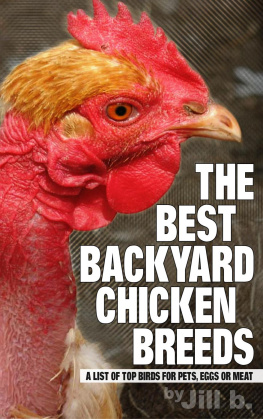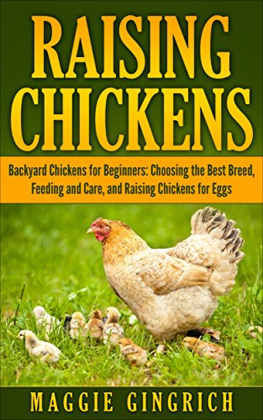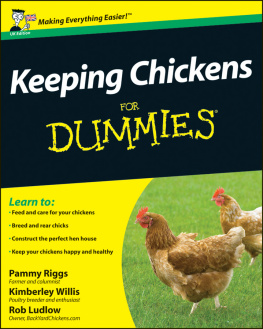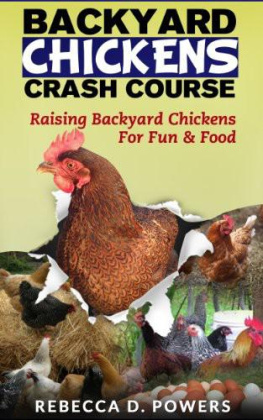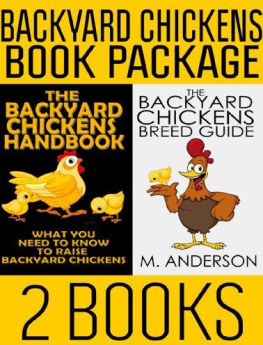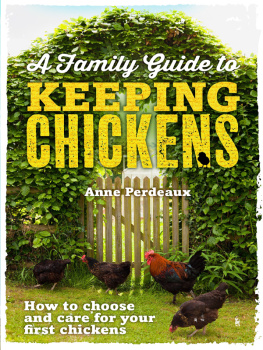AFTERWORD
I often think about what life was like before we had chickens. I cant really imagine life without them, if were being honest. It would be a little too quiet on our homestead without the rooster crowing and the hen singing her egg song.
What I love most about this entire experience, however, is the chance to be part of something greater. My generation is obsessed with chickens, and while it might be a little trendy nowadays, chickens have opened the floodgates to a more sustainable and simple lifestyle. People who raise backyard chickens are more prone to make healthier life choices, like choosing organic items at the grocery store or taking control of their health care by using herbal remedies and natural resources.
While this entire book talks about how to naturally take care of chickens, sometimes I wonder if chickens make us naturally take care of ourselves. We are now in charge of animals that so many of us thought were reserved only for farmers.
Chickens now dot the yards of city subdivisions and rural acreage alike. There is no right or wrong place to house a chicken in modern society. Theyve become an appendage to our busy lives, attaching themselves to us as we attach ourselves to the homesteading lifestyle that we so desperately crave, and some of us are already living.
As a natural chicken keeper, youll feel a sense of worth, as if youve done something better in the world just by raising chickens. Hold on to that, because you have done something better.
Youve enriched the soil that you walk on. Youve raised your familys own food source. Youve taught your children how to be good stewards of the earth. And youve raised livestock in a natural and efficient way, against everything big companies tell you that you must do in order to raise healthy chickens.
You walk to the beat of your own drum, and friend, there are plenty of us that walk right alongside you.
The chicken revolution has begun. Lets make it worth being part of by making a difference in how we raise our chickensnaturally, herbally, and simply, through every single stage of chicken keeping.
CHAPTER
CHICKEN HISTORY AND TERMINOLOGY
Chickens have taken over the world! We can find chickens in most suburban backyards, on commercial farms, and even on postage-stamp-size subdivision properties. Chickens are everywhere in the twenty-first century, and rightfully so. From their amazing egg-laying capabilities to their quirky character traits, chickens are one of the most entertaining and beneficial animals on the homestead. But where did the chicken come from? Why are chickens so popular? And how, exactly, did they get here?
The Early History of the Chicken
We know that chickens have been popular for at least the last 7,000 years. In fact, chicken bones were thought to be found at a dig site in northeastern China, dating all the way back to 5,400 BC. Talk about historic! Or prehistoric?
It is thought that the oldest ancestor of the modern chicken is the red junglefowl, from the genus Gallus (from which all chickens are descended), which wandered across Asia in 3,000 BC and before. It wasnt just the red junglefowl that is thought to have contributed to todays chickens, though. There are many different subspecies of the junglefowl, including the gray junglefowl from southern India and others stretching across Java, Vietnam, Burma, and Bangladesh. Junglefowl were everywhere, much like chickens are today. They were a healthy dual-purpose landrace, offering meat and eggs to farmers and homesteaders.
Egyptians enjoyed the self-sufficiency of chickens so much that they created some of the very first incubators in order to hatch more chicken eggs than a mother hen could. By using a series of connected corridors and vents, the incubating chambers were heated by straw, organic material, and livestock (mostly camel) dung.
Centuries of cross-subspecies breeding led to other types of chickens, and just like that, chickens became a sustainable resource for villagers, homesteads, and even empires. Vikings and settlers carried chickens on boats to new lands and along roadways to new settlements. Soldiers carried chickens in crates on wagons and horseback, never knowing how long theyd be gone. It was easier to get an egg from a chicken (or dispatch the chicken itself) as a source of protein than it was to hunt and trap in the midst of battle.
The chicken was more than just a meat and egg source, though. In many cultures and religions, the hen was seen as a symbol of fertility and motherhood. Likewise, the rooster was seen as a symbol of courage and virility.
According to the writings of Roman politician Marcus Tullius Cicero, at the Battle of Drepana in 249 BC the senior flagship magistrate, Publius Clodius Pulcher, practiced the Roman religious requirement of observing chickens before battle. When offered grain, if the chickens fed well on the grain, it meant the battle would be successful because it was blessed by the gods. If the chickens didnt feed well on the grain, the battle would be lost. Unfortunately, Pulchers chickens didnt eat the grain, and he became so angry that he tossed them overboard. Pulcher lost the battle, leaving almost every single one of his ships at the bottom of the sea. Coincidence?

In the Gospels of the Bible, the rooster was used to fulfill the prophecy of Peter denying Jesus three times before the cock crows, thus signifying that Peter had denied the Savior of the world. Because of this, in the ninth century, Pope Nicholas I ordered that every church place a rooster on top of its roof or steeple as a reminder of this history. To this day, there are still many churches with rooster weathervanes.
Throughout history, chickens have been a noble and sought-after bird. Even today, chickens continue to make history. Many backyards are dotted with foraging chickens, and commercial egg and meat industries have changed the face of our food system, though not necessarily always for the better.
In 1873 the American Poultry Association (APA) was organized in an effort to maintain a standard of excellence for chicken breeds and to establish a way to classify chicken breeds. This is where many of our chicken breeds originated. Almost everything we know about certain breeds is derived from hours of research and observation from the APA. From comb structure to coloring and more, the APA has helped revolutionize the way we see chickens today.
Chicken History in the United States
Since the late 1800s, weve seen an increase in chickens and their uses in the United States, most likely due to the interest of the APA and other organizations. Here is a brief timeline of chickens in the American household from the 1800s to more modern times.



